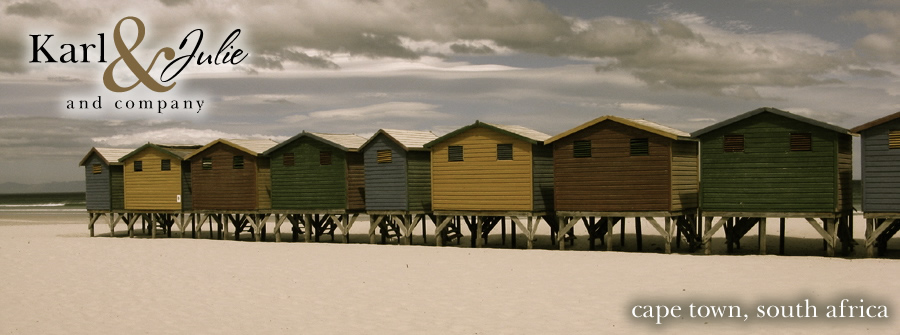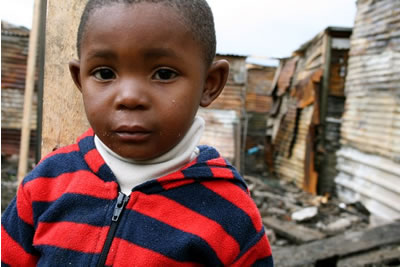 Many
people wonder why all of the time, attention and money have
been given to Africa from Western resources over the last
50 years. Many
people wonder why all of the time, attention and money have
been given to Africa from Western resources over the last
50 years.
The southern half of Africa has the largest amount of...
• Wars
• HIV infected people
• Visible government corruption
• Devastating natural disasters
• Death from preventable diseases
The southern half of the continent has been “Christianized”
– including everything from ancestral worship mixed
with some aspects of Christianity to over 500 types of cults
– but this seems to be a religion of the head and
not the heart.
The true principles of Christianity are not changing lives.
We believe discipleship is the
key to experiencing the real, life-changing love of Jesus.
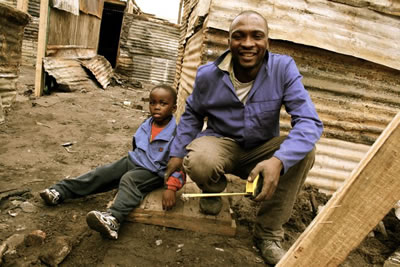 "Diversity
is a key feature of South Africa, where 11 languages are recognised
as official, where community leaders include rabbis and chieftains,
rugby players and returned exiles, where traditional healers
ply their trade around the corner from stockbrokers and where
housing ranges from mud huts to palatial homes with swimming
pools. "Diversity
is a key feature of South Africa, where 11 languages are recognised
as official, where community leaders include rabbis and chieftains,
rugby players and returned exiles, where traditional healers
ply their trade around the corner from stockbrokers and where
housing ranges from mud huts to palatial homes with swimming
pools.
The diverse communities, however, have not had much representation
for long.
Until 1994 South Africa was ruled by a white minority government
which was so determined to hang onto power that it took activists
most of the last century before they succeeded in their fight
to get rid of apartheid and extend democracy to the rest of
the population..." Read
more: BBC News - South Africa country profile
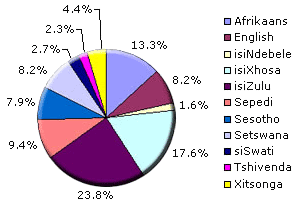 1)
LANGUAGE: The country has 11 official languages. 1)
LANGUAGE: The country has 11 official languages.
- English (being the most widely used)
- Afrikaans (a language developed by the region's early
Dutch settlers)
- 9 native African languages (see list below)
2) SIZE: South Africa is almost
twice as big as Texas and three times the size of California.
3) TVS: There is one TV set for every eight
people in South Africa. In the U.S. there are four TV sets
for every five people.
4) GOLD: Almost 40 percent of the gold mined
on Earth has come from South Africa.
5) WILDLIFE: South Africa has one of the
world's great wildlife sanctuaries. It's called Kruger National
Park and roaming free through the park are more than 500 different
types of birds and 147 different mammals, including lions,
leopards, elephants, water buffaloes and rhinos.
6) CLIMATE: Because it's below the equator,
South Africa's summers begin in September and last until April.
Daytime temperatures during the summer range from the 60's
to the 90's. The nicest weather is usually in April and May.
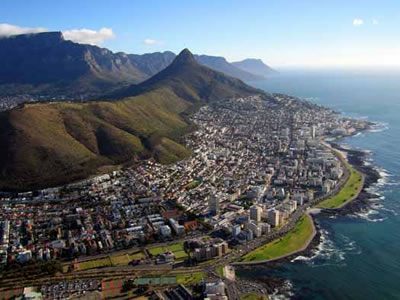 7)
HISTORY: Jan van Riebeeck and the 90 men who landed
with him in 1652 at the Cape of Good Hope, under instructions
by the Dutch East India Company to build a fort and develop
a vegetable garden for the benefit of ships on the Eastern
trade route...Read
more» 7)
HISTORY: Jan van Riebeeck and the 90 men who landed
with him in 1652 at the Cape of Good Hope, under instructions
by the Dutch East India Company to build a fort and develop
a vegetable garden for the benefit of ships on the Eastern
trade route...Read
more»
8) APARTHEID: From 1948 until 1994 the South
African government enforced an official policy of apartheid.
This not only made it a law for the races to stay separate,
but it also allowed the white minority, although outnumbered
4 to 1 to control the country.
Racial segregation in South Africa began in colonial times,
but apartheid as an official policy was introduced following
the general election of 1948.
New legislation classified inhabitants into racial groups
("black", "white", "coloured",
and "Indian"), and residential areas were segregated
by means of forced removals into townships.
From 1958, Blacks were deprived of their citizenship. The
government segregated education, medical care, and other public
services, and provided black people with services inferior
to those of whites.
Read more»
WHAT IS A TOWNSHIP?
In South Africa, the term township usually
refers to the (often underdeveloped) urban living areas
that, under Apartheid, were reserved for non-whites
(principally black Africans and Coloureds, but also
working class Indians). Townships were usually built
on the periphery of towns and cities.
During the Apartheid
Era blacks were evicted from properties that were in
areas designated as "white only" and forced
to move into townships.
Legislation that enabled the Apartheid
government to do this included the Group Areas Act.
Forced removal from city centres to townships has continued
in post-apartheid South Africa. The difference is that
under apartheid all black people faced forced removals
to townships, while now it is only the poor living in
shack settlements that face eviction. Read
more» |
9) POPULATION:
- African/ Black (79.5%)
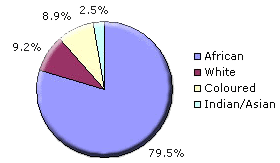 White
(9.2%) - usually those of a Dutch or English descent White
(9.2%) - usually those of a Dutch or English descent
- Roughly 60% of white South Africans speak Afrikaans
as their mother language and about 39% speak English.
Speakers of Afrikaans refer to themselves as Afrikaners.
- Unlike the Afrikaners, the English speakers have not
constituted a coherent political or cultural entity
in South Africa. Hence, the absence of a commonly accepted
term to designate them, although 'English South African'
or 'English-speaking South African' is used.
- Coloured (8.9%) - an ethnic group of
mixed-race people who possess some sub-Saharan African ancestry,
but not enough to be considered Black under the law of South
Africa. Most Coloured South Africans have a cultural identity
distinct both from that of Blacks and Whites. The majority
speak Afrikaans. Although "coloured" is an offensive
term in the United States, this is the widely used term
in South Africa.
- Indian/Asian (2.5%)
10) GEOGRAPHY: South Africa, on the continent's
southern tip, is bordered by the Atlantic Ocean on the west
and by the Indian Ocean on the south and east. Its neighbors
are Namibia in the northwest, Zimbabwe and Botswana in the
north, and Mozambique and Swaziland in the northeast.
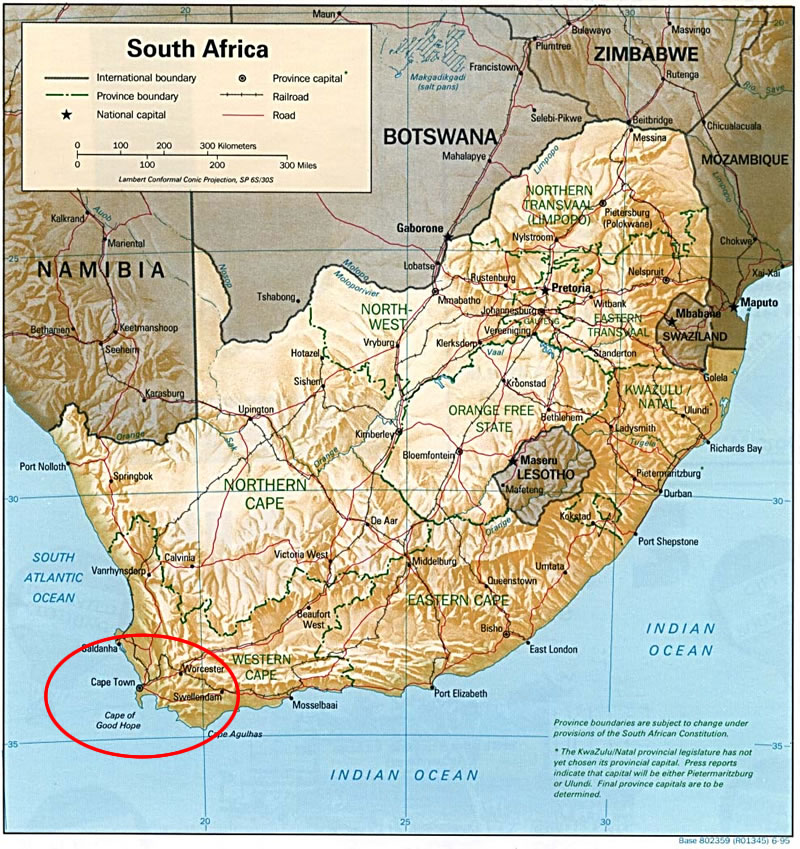
Sources and other resources:
|

